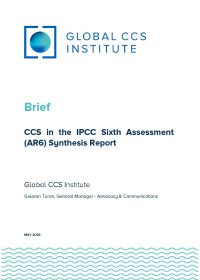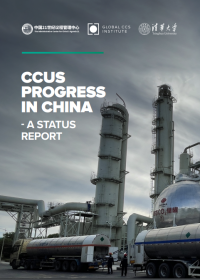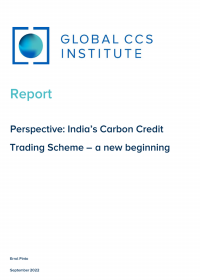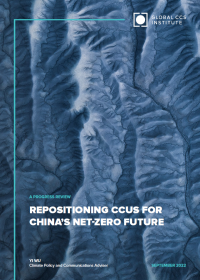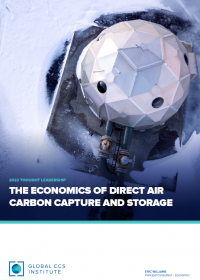Resources
Publications
Our publications, reports and research library hosts over 500 specialist reports and research papers on all topics associated with CCS.
View our Publication Library Disclaimer.
Filter by
Read the Institute's thought leadership report titled "The Investment Case for CCS: Policy Drive and Case Studies", which highlights available policy tools supporting carbon capture and storage (CCS) investment and provides key insights into what is necessary to accelerate capital flows.
Over the past two years, there have been significant policy and regulatory developments aimed to reduce GHG emissions, notably the 2022 Inflation Reduction Act (IRA) in the United States and the EU’s Fit for 55 package. The introduction of strong and decisive policies and regulations has led to an exponential increase in the announcement of CCS investments, improving the business case for CCS projects.
Authored by the Institute’s Principal Consultant Finance, Selim Cevikel, and Deputy Principal Consultant CCS Technologies, Jerrad Thomas, this thought leadership report provides readers with an overview on:
- The economic value of CCS and the policy toolbox needed to drive demand for CCS applications, including associated risk factors
- Key policy drivers supporting CCS development in United States, the European Union and Japan
The report also includes three case studies assessing:
- Clean hydrogen and ammonia production
- Midwest CCS CO2 hubs
- CCS in power generation
Disclaimer
The content within the Global CCS Institute Publications, Reports and Research Library is provided for information purposes only. We make every effort and take reasonable care to keep the content of this section up-to-date and error-free. However, we make no claim as to its accuracy, currency or reliability.
Content and material featured within this section of our website includes reports and research published by third parties. The content and material may include opinions and recommendations of third parties that do not reflect those held by the Global CCS Institute.
The Global CCS Institute is pleased to publish its flagship CCS technology compendium titled State of the Art: CCS Technologies 2023.
The compendium showcases a wide range of commercially available CCS technologies, providing readers with insights on the latest advancements made globally.
In this second annual release – led and coordinated by the Institute’s Matthew Loughrey, Hugh Barlow and Shahrzad Shahi – the compendium provides an overview of over 70 technologies and solutions, along with details surrounding key benefits and relevant facts and figures tied to the innovations highlighted.
Download your copy today.
Disclaimer
The content within the Global CCS Institute Publications, Reports and Research Library is provided for information purposes only. We make every effort and take reasonable care to keep the content of this section up-to-date and error-free. However, we make no claim as to its accuracy, currency or reliability.
Content and material featured within this section of our website includes reports and research published by third parties. The content and material may include opinions and recommendations of third parties that do not reflect those held by the Global CCS Institute.
Read the Institute’s publication titled ‘CCS Milestones on the Road to COP28’, which uncovers international and national policy actions and discussions taken ahead of the 28th Conference of the Parties (COP28).
With COP28 being held from 30 November-12 December in the United Arab Emirates, carbon capture and storage (CCS) saw multilateral attention during the first half of 2023. However, improvements related to the coherence of CCS remain, particularly as opportunities to facilitate the deployment of the technology grows during this critical decade of action.
Authored by the Institute’s Senior International Climate Change Policy Adviser, Noora Al Amer, this report highlights and assesses a number of milestones reached ahead of COP28 as it relates to CCS, including:
- The release of the IPCC AR6 Synthesis Report, that marked CCS as an option to reduce emissions from industry. The report will support and inform the first Global Stocktake at the upcoming COP28.
- The latest political positioning on CCS issues, including through the Carbon Management Challenge and G7 and G20 activities
- The IEA’s Credible Pathways to 1.5°C Report, released in April 2023, which puts an emphasis on the need for CCS to tackle emissions from the energy sector
- The outcomes of the Bonn Climate Conference, where CCS was addressed formally in negotiation rooms
Opportunities to support and inform CCS and climate discussions at COP28 are ongoing for governments, industry players, ENGOs, civil society organisations and relevant stakeholders. Download the report today to get up to date on the latest details.
Disclaimer
The content within the Global CCS Institute Publications, Reports and Research Library is provided for information purposes only. We make every effort and take reasonable care to keep the content of this section up-to-date and error-free. However, we make no claim as to its accuracy, currency or reliability.
Content and material featured within this section of our website includes reports and research published by third parties. The content and material may include opinions and recommendations of third parties that do not reflect those held by the Global CCS Institute.
Read the Global CCS Institute’s latest thought leadership report, which evaluates the role of CCUS in supporting India’s climate ambitions, highlights the authorisation of India’s carbon credits trading scheme, and assesses the release of the Indian government’s detailed report on CCUS.
In 2022, India’s central government passed an amendment to the Energy Conservation Bill into law, marking a significant step for the set-up of a carbon trading system in India. The NITI Aayog, an Indian central governmental think tank, also released a policy framework paper in 2022 on CCUS that acknowledged the role of CCUS in decarbonisation and the development of a low-carbon economy.
These developments, together with the government’s announcement to establish two National Centres of Excellence in Carbon Capture and Utilization, demonstrates India’s intention to fill in the blanks on the components needed for viable domestic emissions reduction pathways.
Titled ‘India’s Carbon Credit Trading Scheme & the Indian Government’s CCUS Report,’ this publication is the second report in an Institute series analysing India’s climate ambitions.
This report provides readers with an overview on:
- The impact and significance of the establishment of a national carbon credit trading scheme, as it relates to domestic companies seeking to reduce emissions
- The growing drive by India’s government to better understand CCUS technology and build opportunities for further research, development and collaboration
- Climate ambition and leadership in the country, including India’s G20 presidency, a brief overview of the country’s emissions reduction commitments, and updates to India’s Nationally Determined Contributions (NDCs) submitted to the UNFCCC
Disclaimer
The content within the Global CCS Institute Publications, Reports and Research Library is provided for information purposes only. We make every effort and take reasonable care to keep the content of this section up-to-date and error-free. However, we make no claim as to its accuracy, currency or reliability.
Content and material featured within this section of our website includes reports and research published by third parties. The content and material may include opinions and recommendations of third parties that do not reflect those held by the Global CCS Institute.
On 20 March 2023, the Intergovernmental Panel on Climate Change (IPCC) published its Synthesis Report for the Sixth Assessment Report (AR6). Building on the Special Report of 1.5 °C and the WGIII Report on Mitigation, the AR6 Synthesis Report: Climate Change 2023 once again highlights the importance of carbon capture and storage (CCS) in addressing climate change.
This latest brief published by the Global CCS Institute unpacks the Synthesis Report and highlights key takeaways, as it relates to the role carbon capture and storage is expected play in supporting international climate targets.
Disclaimer
The content within the Global CCS Institute Publications, Reports and Research Library is provided for information purposes only. We make every effort and take reasonable care to keep the content of this section up-to-date and error-free. However, we make no claim as to its accuracy, currency or reliability.
Content and material featured within this section of our website includes reports and research published by third parties. The content and material may include opinions and recommendations of third parties that do not reflect those held by the Global CCS Institute.
Read the Institute's latest publication, which highlights CCUS progress in China.
China has made significant progress in CCUS technology development in recent years, and has acquired the capability to design and demonstrate large-scale CO2 capture, transport, utilisation and storage systems.
This latest report, written in collaboration with Tsinghua University and the Administrative Centre for Agenda 21, provides an overview of CCUS policy development, and provides relevant policy recommendations aimed to support the scale up of CCUS in China.
With the English version of the report released on March 17, the publication is also now officially available in Chinese from July 10 onward.
CCS Progress in China - Chinese
CCUS Progress in China - English
Disclaimer
The content within the Global CCS Institute Publications, Reports and Research Library is provided for information purposes only. We make every effort and take reasonable care to keep the content of this section up-to-date and error-free. However, we make no claim as to its accuracy, currency or reliability.
Content and material featured within this section of our website includes reports and research published by third parties. The content and material may include opinions and recommendations of third parties that do not reflect those held by the Global CCS Institute.
The Global CCS Institute is pleased to announce that the Global Status of CCS 2022 report is now available in Arabic.
The report documents important milestones for carbon capture and storage (CCS), its status across the world, and the key opportunities and challenges the technology faces. The report also includes detailed analyses of the global project pipeline, international policy, carbon markets, carbon removals, and the evolution of storage.
The Status Report provides a global snapshot of CCS progress, highlighting the rapid development of CCS across North America, Asia Pacific, Europe and the UK, and the MENA region.
Download the PDF of the Global Status of CCS 2022 report in Arabic below.
To view the interactive Global Status of CCS Report website in English, click here.
Disclaimer
The content within the Global CCS Institute Publications, Reports and Research Library is provided for information purposes only. We make every effort and take reasonable care to keep the content of this section up-to-date and error-free. However, we make no claim as to its accuracy, currency or reliability.
Content and material featured within this section of our website includes reports and research published by third parties. The content and material may include opinions and recommendations of third parties that do not reflect those held by the Global CCS Institute.
During the UN Climate Change Conference (COP 27) held between 6 and 18 of November 2022, all Parties to the UNFCCC came together to effectively tackle climate change and ensure the full implementation of the Paris Agreement.
The Institute was on the ground in Sharm el-Sheikh as an Observer to follow the negotiations process, engage in CCS relevant discussions as well as host and take part in several side events.
In this newly released report, we outline our main takeaways from COP 27 from a CCS perspective, assessing the road ahead for net-zero targets and international climate policy. The report further unpacks:
- The Global Stocktake (GST) and its impacts
- Key decisions on Article 6
- The forum on the implementation of response measures
- The newly established joint work programme of the Technology Executive Committee (TEC) and the Climate Technology Centre and Network (CTCN)
The report, authored by the Institute's Senior Policy Adviser on International Climate Change, Noora Al Amer, is part of a series dedicated to COP 27 and the role of CCS in the implementation of the Paris Agreement.
Disclaimer
The content within the Global CCS Institute Publications, Reports and Research Library is provided for information purposes only. We make every effort and take reasonable care to keep the content of this section up-to-date and error-free. However, we make no claim as to its accuracy, currency or reliability.
Content and material featured within this section of our website includes reports and research published by third parties. The content and material may include opinions and recommendations of third parties that do not reflect those held by the Global CCS Institute.
Republished with the permission from the author, Dr. Julio Friedmann, Chief Scientist at Carbon Direct and Distinguished Fellow at the Global CCS Institute. This commentary builds on the paper, The Economics of Direct Air Carbon Capture and Storage, published by Eric Williams, Principal Consultant – Economics at the Global CCS Institute.
If you’ve ever wondered how the cost of CO2 removal (CDR) might affect future energy and climate outcomes, you’re not alone.
Recently, Eric Williams at the Global CCS Institute published an interesting set of economic analyses around global decarbonization. The new report attempts to answer a very simple question: how could the costs alone of direct air carbon capture and storage (DACCS) affect climate outcomes?
There’s reasons to believe this question, and hence the new analysis, is important. Recently, the Intergovernmental Panel on Climate Change (IPCC) released its 2022 report on climate mitigation. The consensus conclusion of 190 nations was clear – CO2 removal was necessary to achieve key climate goals, including any net-zero target, and that engineered pathways were essential to do so. This is matched by other 2022 analyses, including the International Energy Agency (IEA) and the Energy Transition Commission (ETC).
All three groups place special emphasis on one CDR technology – direct air capture, or DAC, which separated CO2 from ambient air for use or disposal. Specifically, all three focus on combining direct air capture with geological carbon storage (direct air carbon capture and storage, or DACCS). They do so for good reasons, spelled out by both the National Academies and Royal Philosophical Society.
- DACCS is not limited by scale – in terms of available low-carbon energy, land use, or geological storage.
- DACCS is not geographically limited. It can be deployed more or less anywhere there is low-carbon energy and CO2 storage – in many nations and continents.
- DACCS acts like a “backstop” technology for climate. If other mitigation pathways are super expensive, DACCS can be deployed.
As a climate backstop, there is only one major limit to DACCS: cost. Today, commercial prices for DACCS exceed $500/ton removed, reflecting high capital and operating costs. In his analysis, Mr. Williams always uses the same climate outcome as a baseline – 1.5C in 2050. His models include all the other elements of the system (hydrogen, efficiency, renewables, CCS, nuclear) and solely vary the cost of DAC capture from run to run.
This change alone – price of DACCS – affects important outcomes: the timeline for deployment, the amount of global energy production, the total economic costs, the energy mix, and more. Like a classic partial-differential equation problem (keep all other inputs constant, vary one parameter, and see how that affects the other variables), his approach provides insights into how DAC costs affect a key climate target, and what the implications are if DACCS costs drop quickly or not.
A few findings from the report match expectations.
- Low-cost DAC deploys sooner than high-cost DAC
- Low-cost DAC means more overall deployment of CO2 removal.
- Low-cost DAC can save trillions of dollars from the total climate bill compared to high-cost DAC.
A few are somewhat surprising or counter intuitive. For example:
- Low-cost DAC decreases the amount of total energy used.
- The cost of DAC does not substantially affect fossil energy production or consumption
It’s worth unpacking the report and a few key analyses to help explain these findings. Recommended actions require no massive changes to infrastructure, the world economic system, or national policies. The potential prizes, both monetary and environmental, are enormous.
Approach
As in any study of this kind, methodology and assumptions matter. Specifically, Mr. Williams used the Open Source Energy Modeling System (OSEMOSYS), a least-cost optimization model similar to MARKAL and TIMES, across four groupings of countries (advanced economies, the BRICS countries, the Middle East, and the rest of the world). The model finds the last cost of reaching net zero with rich detail in technology options, including energy efficiency, renewables, electrification, and alternative fuels (including biofuels, hydrogen). Modules of geological CO2 storage & DAC feature updated costs for compression and storage. Specific details to DAC include 31 different starting costs and modest learning rates (0.3%/y capex and 0.5%/y opex reductions) starting in 2035 – ultimately rather conservative assumptions. Details can be found in the original report and detailed description of the model in a related short paper.
It’s important to remember in reviewing the model results that they are constrained in time. All models must reach net-zero by 2054. This means if DACCS cannot deploy quickly enough or cheaply enough, then something else must come in to deliver abatement.
In the report, the author selects three specific cases to help illuminate the impacts on outcomes: low-cost (~$137/ton), medium cost ($223), and high-cost ($411/ton). The cases are all in costs (capture, transportation, and storage per ton CO2) and globally averaged. Again, it does not discuss the likelihood of reaching these price points, but rather the impact of achieving climate abatement at that cost.
Unsurprisingly, low-cost DACCS deploys in volume earlier than high-cost DAC and delivers more total global abatement (figure 3 from the report).

Perhaps less obvious, having low-cost DAC means less CCS on hydrogen systems, especially CCS for blue hydrogen facilities, and for some power facilities (figure 4 from the report). This is driven by the model’s cost optimization algorithms; in short, low-cost DACCS means less CCS is needed on the high-cost parts of the hard-to-abate sectors. This is like using the vacuum at some point instead of picking up all the little bits from the floor – is cheaper and easier.

System costs
Many groups have estimated the savings associated with carbon management to achieve net zero (including the IPCC and GoldmanSachs). All agree that DACCS delivers cost optimization in achieving net-zero – in the case of GoldmanSachs, that DACCS at $300/ton would save ~$3 trillion dollars on the bill to reach key climate targets.
This study looks simply at the cost and time of DAC deployment. The conservative assumptions (described above) provide a similar answer – low-cost DAC saves money on the total climate bill on a net-present value basis (Fig. 5 from the report). Similarly, if DAC does not realize costs below $300/ton by 2035, it doesn’t save much because it won’t deploy until 2050.

The same logic drives the models to see more abatement through DAC at lower costs (figure 9 of the report). At low-to-moderate costs, DAC delivers 2-6 Gt of removal as part of a 1.5-by-2054 campaign. At higher costs, other CO2 removal approaches (e.g., BECCS) deliver more, but with limited deployment that drives high costs solutions in key sectors.

This is the key point. The time constraints of 2054 drive the trade-offs in solution space. If any CO2 reduction pathway is more expensive than a CO2 removal pathway the CDR pathway will deploy first. The reverse is also true. Similarly, if DAC is more expensive than forests or BECCS it won’t deploy until resource constraints drive the modeled costs of other pathways above DAC.
Energy needs
A striking and surprising result in how low-cost DACCS leads to system-wide lower use of energy (figure 11 of the report). Given that DAC uses a lot of energy, this appears counter-intuitive at first. However, when modeled DAC costs are high, the system uses more green hydrogen and synthetic fuels, which themselves require enormous energy to use. This is basically a Second Law of thermodynamics result – building fuels out of water and CO2 takes a lot of primary energy, in these cases delivered by extraordinary buildouts of solar and wind (a 200 Exojoule per year difference between high- and low-cost DACCS).

The same is specifically true for just the electricity sector within the global economy (figure 13 of the report). It shows the specific trade-offs, for example how high-cost DAC means less solar electricity use for DACCS and a lot more solar electricity use for hydrogen (figure 15 of the report).


It’s possible that technology innovation in green hydrogen and synthetic fuels would reduce this energy burden. Indeed, other studies suggest that an innovation agenda should target reduction of overpotential and catalyst selectivity as ways to drive down costs. As a policy position, innovation budgets should rationally support multiple pathways – DAC, synthetic fuels, and green hydrogen – as a way to limit overall risk and costs.
The punchline: It’s worth a lot to accelerate DAC cost reductions
If these findings are directionally right, then accelerating DAC cost reductions should be a global priority. The energy savings and avoided costs could prove enormous. The NPV savings could approach or exceed $3 trillion, and the risk of meeting climate targets would drop substantially because of access to a low-cost backstop.
More than anything else, this suggests an innovation agenda, similar to those proposed in 2017, 2018 and 2020. Several nations have policies that support research, development, and demonstration of DACCS, including the US, Canada, UK, EU, and Japan. The Mission Innovation multi-national effort has created a new CO2 removal mission, led by the US, Canada, and Saudi Arabia, that specifically includes DACCS. In addition to increased funding for use-inspired science (e.g., novel sorbents) and applied science (e.g., novel reactors), specific funding should be allocated to large-pilots and demonstrations. To maximize the rate of progress and accelerate learning, policies should also support information sharing between nations as a priority, through bilateral and multilateral arrangements (like Mission Innovation).
Incentives to accelerate DACCS deployment would also provide national and global public benefit (i.e., to facilitate learning rates and cost reductions). Since Nov. 2021, the US has enacted specific DAC deployment policies, including enhanced 45Q tax credits (Inflation Reduction Act) and $3.5 billion for DAC Hubs (Infrastructure Investment and Jobs Act). Additional provisions include a government-sponsored commercial DAC Prize and CO2 storage site assessment. New provisions have been proposed including government procurement (US), additional tax credits (Canada) and incorporation into compliance markets (EU).
Governments are not alone in supporting opportunities. There’s also an important role for companies – specifically, as first movers. The World Economic Forum launched a new plank to the First Movers Coalition, including multiple facilities and commitments for DACCS and other forms of durable CO2 removal. Individual companies such as Microsoft, Airbus, and Swiss Re have purchased DACCS to help stimulate market growth and cost reductions. Even bands like Coldplay have announced the use of DACCS to remove emissions associated with their tours. Many more companies could make similar kinds of DACCS purchases as part of their net-zero strategy and commitments.
Ultimately, the specific party or mechanism is less important the investing in innovation and deployment to drive down costs. The potential prize is enormous. The new report from the Global Institute makes the case, concluding that DACCS cost reductions have reached their Nike moment: Just Do It.
After all, when it comes to climate change, it’s about time.
Disclaimer
The content within the Global CCS Institute Publications, Reports and Research Library is provided for information purposes only. We make every effort and take reasonable care to keep the content of this section up-to-date and error-free. However, we make no claim as to its accuracy, currency or reliability.
Content and material featured within this section of our website includes reports and research published by third parties. The content and material may include opinions and recommendations of third parties that do not reflect those held by the Global CCS Institute.
India’s Carbon Credit Trading Scheme – a New Beginning
13th September 2022
Topic(s): Carbon markets, India
In August 2022, the Lower House of India's Parliament passed a bill to establish a domestic carbon credit trading scheme. The passing of the bill highlights the Government's focus on creating a climate mitigation framework that builds on the most flexible elements of international developments to meet its climate targets.
Although CCS is being evaluated in India, there is no timeline providing clarity about when CCS may be included in India's climate plans. However, the amendment indicates a new era for India in its quest to reduce emissions and meet climate commitments. Like carbon trading systems elsewhere, CCS projects may later be included and benefit from an Indian carbon market.
Disclaimer
The content within the Global CCS Institute Publications, Reports and Research Library is provided for information purposes only. We make every effort and take reasonable care to keep the content of this section up-to-date and error-free. However, we make no claim as to its accuracy, currency or reliability.
Content and material featured within this section of our website includes reports and research published by third parties. The content and material may include opinions and recommendations of third parties that do not reflect those held by the Global CCS Institute.
China has committed to achieving carbon neutrality before 2060, representing a serious pledge from top-level leadership while providing an enormous task to realise in just forty years. If CCUS is to play the intended critical role in China’s net-zero effort, more work needs to be done to achieve the technology suite’s potential.
This report reviews the status of carbon targets, examines the trends and challenges for CCUS in China,
and looks at the push across low-carbon industrial transformation. The report identifies a potential role for international cooperation in accelerating the commercial deployment of CCUS in China. Through knowledge sharing and joint projects, international cooperation can enhance public acceptance, close technological gaps, realize broader collaboration, and reduce costs and risks.
Disclaimer
The content within the Global CCS Institute Publications, Reports and Research Library is provided for information purposes only. We make every effort and take reasonable care to keep the content of this section up-to-date and error-free. However, we make no claim as to its accuracy, currency or reliability.
Content and material featured within this section of our website includes reports and research published by third parties. The content and material may include opinions and recommendations of third parties that do not reflect those held by the Global CCS Institute.
The Economics of Direct Air Carbon Capture and Storage
26th July 2022
Topic(s): Carbon capture and storage (CCS), CO2 removals, Direct air carbon capture and storage (DACCS), Economics
Carbon capture and storage (CCS) is a set of technologies that capture CO2 from large emission sources or from the atmosphere and safely stores it underground or permanently in products. As the scale and urgency of climate action has become clearer in recent years and governments and companies have done the necessary work to map their own pathways to climate neutrality, carbon dioxide removal (CDR) technologies - direct air carbon capture and storage (DACCS) in particular - have become a focal point in climate mitigation.
This paper explores the economics of DACCS, relying on the economic model described in the methodology, in which actors within the energy system are free to pursue least-cost options in meeting net-zero pathways. The intent of the paper is a thought experiment to show how DACCS deployment might affect the global energy system. It focuses solely on the cost of DACCS - applying no additional policy assumptions - and is not a forecast.
The paper finds that:
- DACCS plays a unique role among technological climate mitigation options as it can function as a backstop technology, potentially avoiding climate disaster if other low-cost pathways are not realised.
- Low-cost DACCS, should it be realised, would reduce the total cost of decarbonisation and meeting climate goals.
- If DACCS deployment is limited due to high costs, the main decarbonisation pathway for industry and transport (except light duty vehicles, which are electrified) is hydrogen.
- Electricity generation, buildings, and light vehicles are largely unaffected by the deployment of DACCS and decarbonise through increased efficinecy and renewable energy pathways.
- The challenge inherent for governments is to implement policy and provide incentives for immediately available mitigation pathways, while supporting the development and commercialisation of lower-cost DACCS.
Download a description of the economic model used in this paper here.
Disclaimer
The content within the Global CCS Institute Publications, Reports and Research Library is provided for information purposes only. We make every effort and take reasonable care to keep the content of this section up-to-date and error-free. However, we make no claim as to its accuracy, currency or reliability.
Content and material featured within this section of our website includes reports and research published by third parties. The content and material may include opinions and recommendations of third parties that do not reflect those held by the Global CCS Institute.




